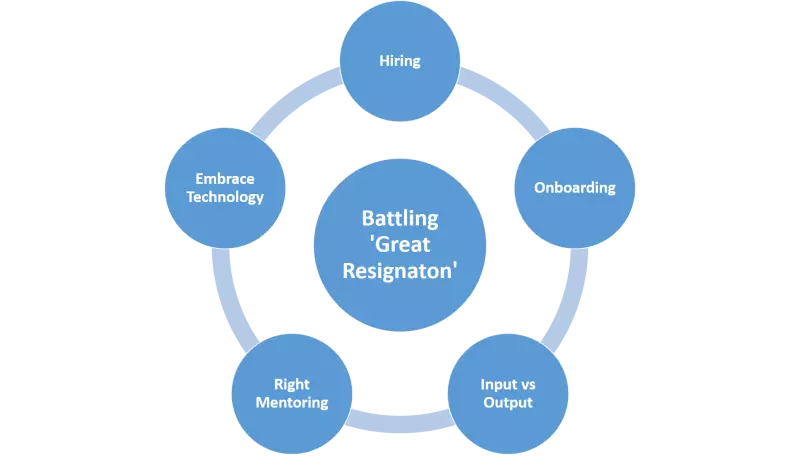Indian Retail Scenario – 2030

The Indian retail industry is one of the fastest-growing in the world, slated to grow at a rate of over 9% in the period 2019 to 2030, from USD 779 billion in 2019 to more than USD 1.8 trillion by 2030 as per Kearney Research. Being the fifth-largest and a preferred retail destination globally, the country ranks amongst the highest in the world on per capita retail store availability. India’s retail sector is experiencing exponential growth with retail developments not just in major cities and metros, but in tier II and tier III cities as well.
However, with growth comes competition and with competition comes the urge to succeed for survival, especially during the Covid-19 pandemic. This onus to succeed relies heavily on frontline sales professionals who need to grind hard in an industry that typically offers low margins of profit. This additional pressure to revive sales in the aftermath of the Covid-19 pandemic as well as certain other factors such as burnout, hostile work environment and better opportunities in other places are combining to contribute to what is being hailed as the ‘great resignation’, an infamous global trend, which is now a reality in the Indian retail industry. Here are five ways, based on my experience to address the root cause behind these persistent resignation:

Hiring Right, The First Time, Every Time!
Although everyone knows that hiring the right talent is an important business differentiator yet due to rapid growth, supply challenges and other problems, we inadvertently overlook this requirement and end up compromising on this crucial need. The ill effects of this miss can be witnessed sooner or later and both the company as well as the newly hired employee suffer in different ways. The former encounters high employee turnover, the latter is unable to contribute in a role where they are a misfit. Hiring right is the foundation as well as the first step towards fighting the ‘great resignation’.

Wow Onboarding Experience
Research by Gallup suggests that only 12% of employees strongly feel that their organization provides a great onboarding experience. Our own experience across retail clearly indicates a similar outlook as it is one of the biggest factors responsible for high attrition rate.
Here are some practices to AVOID:
-
-
Late Onboarding
Minimum threshold numbers or challenges across geographically dispersed new hires are things of the past. With digital onboarding as an option, you can actually implement zero-touch induction with an absolute personalized experience.
-
Manager/Mentor Missing in Action
Leaving new hires at the mercy of a mentor who himself struggles to deliver/devote time to new hires is another recipe for disaster.
-
Information Overload
Too much download in the first few days not only reduces the retention rate but is also a huge factor in confusing the candidate & bringing down energy.
-
Abandoning Candidate too early
Not keeping a tab is detrimental. Personal connect should not be missed.
-
On the other hand, here are some ‘MUST FOLLOW’ practices:
-
-
-
Comforting the New Hires
Make employees comfortable in their new working environment by providing them with all the facilities and instructions that they need.
-
Involvement of Managers
Managers must make a conscious effort in terms of their active involvement in the process of employee acclimatization.
-
Socialization
Aim at cultivating a sense of belonging within new hires from the very start. Ice-breaking and socialization are highly critical, especially in a new environment.
-
Addressing the Issues
In the retail industry, where 30% new hires leave within a period of 60 days, it’s important to be vigilant, especially during this period. An attempt should be made to address the underlying issues that result in resignation.
-
Promising a Bright Future
Make the new hires aware of their career progression, potential opportunities in the form of promotion criteria to boost their morale.
-
Aligning the New Employees
Make sure the new hires understand their role and the organization’s expectations from them. Align them with the organization’s vision, culture, practices and management approach.
-
-
If you are to embrace technology, there are now multiple collaboration tools or even basic LXP features that allow you to keep a track of progress. These tools also help in bonding the team together. Given the advancements in technology, it is obvious to move away from the traditional forms of onboarding. Generally, a long onboarding process is more beneficial, however, in certain industries such as retail it is difficult as new hires need to get up-to-speed in a short span of time. Nevertheless, the process should be employee-friendly, remember the first impression is the last impression, and a good first impression is crucial to engage your new employees.
Why Focussing on Input rather than Output Matters?
One of the largest Auto OEMs faced over 30% Attrition of ‘Customer Service Advisors’ (i.e. Sales Executive) at various dealerships. The entire sales organogram right from the Dealer Principal to the Sales Director shared data on sales productivity & it was found that only the non-performers were leaving.
On a deeper performance analysis, it was found that almost 50% of the new hires were not given any enquiries & there was a huge disparity in the allocation of leads with older executives getting all the hot leads. This, in turn, hindered the new employees’ ability to perform & inevitably they lost motivation in the system, thus there was attrition among new joinees.
It’s a universal fact that sales is a numbers game but emphasis and sharpening your focus on input is always advisable, especially in the first 90 days where the organization must thoroughly invest in training and support. The new professionals especially in the retail sector must be guided towards the right sales processes. They must learn how to be consistent in their approach. Learning the usage of tools such as CRM can be leveraged to manage key accounts, particularly at the frontline level. In addition, the new hires mustbe encouraged to make connections both within and beyond the sales domain. Let them learn by witnessing and reflecting upon the process followed by their seniors who are experienced professionals. These professionals must be supportive in this learning process. Also, it is important for organizations to establish a forum among the new hires where they can learn by sharing experiences with each other.
A new sales professional who is well-trained is always in a better position to deliver results. Training, however involves time. The organization must stay patient and not rush in its approach. The focus should always be on inputs, as they say practice makes perfect. The seniors certainly need to guide and encourage.
“If you’re putting in the effort, and focusing on the inputs, the results will follow!”
Appointing the Right Buddy or Mentor
Pradeep joins a big telecom handset company as a store promoter. Post the 3-day onboarding, Amresh, his peer at the shop is assigned as his mentor. While Amresh is a star performer who knows the ropes and his duty as a mentor is to train, showcase, monitor, teach how to apply learned skills on the job and settle Pradeep in the new environment. Amresh, however is so engrossed in achieving his own numbers and earning incentive/recognition that settling Pradeep never becomes his priority. In the entire design especially at the frontline role, till you link the new employee’s performance with the assigned mentors, the due focus remains missing.
Appointing the right buddy or mentor is vital. But how does that happen? The basic ingredient here is the process of selection. Not everyone is suited for delivering the duties of a mentor. Appointing mentors like Amresh can prove detrimental both for the new employee and the organization. The selection of a mentor should be based on certain parameters.
The first parameter is ‘personality fit’. Like-minded people or people with similar strengths and weaknesses are more likely to work better together. Analyse the behaviour and personality traits of the new hire by finding someone in the organization who aligns well with them. The second parameter is the ‘ability to train’, a mentor should possess the capability to teach, train and guide the new hire. Thirdly, it is better for a mentor to be experienced in terms of completing a similar role for which a new hire has been hired. Furthermore, the mentors should be trained, governed and motivated by the organization to serve their duties in an effective manner. This not only benefits the new hires but also allows mentors to improve and enhance their leadership skills.
“Well defined & structured mentoring process along with rightful upskilling of mentors on training/coaching is a key to the successful mentoring process”
How can you leverage Technology for Learning & Engagement?

Gone are the days when you had 25-30 learners in a batch who were provided uniform training lessons. With technology at the forefront, you can now offer a clearly defined and personalized learning journey, that too anytime and anywhere. The beauty of this entire approach lies not only within the real democratization of learning but also through the strength of AI-enabled tools, that can actually plug/play in real-time around the key skill gaps observed in employees using analytics that can prepare customized reports based on the learning data.
Specialized programs like zero-touch onboarding backed with the principles of adaptive learning can not only show you the needle movement but also are quite handy to deliver a predictive analysis on who could be your future rock stars, as well as who reflect a high probability of quitting. This ensures the reporting managers work on the right areas.
Employee turnover is a menace. It has severe implications in terms of cost and time for an organization that needs to start from scratch to fill in the place of an employee who resigns. Being forced to undergo the same process of recruiting, hiring, onboarding and training in a cyclic manner, organizations need to reassess their practices that serve as an important contributor to the ‘great resignation’ drive.
Under such a situation, having an employee-centric focus becomes the need of the hour. This focus can be cultivated with the incorporation of technology in the process of employee learning and development. It’s time to bank on the advancements of digital learning platforms that can serve as a comprehensive solution to your multiple problems such as hiring the right set, effective onboarding and impactful training of employees, especially for frontline workers in the retail industry, where everything moves fast, even the ‘great resignation’. Nevertheless, there’s always a solution in the form of these aforementioned best practices that need to be followed with consistency and determination.


